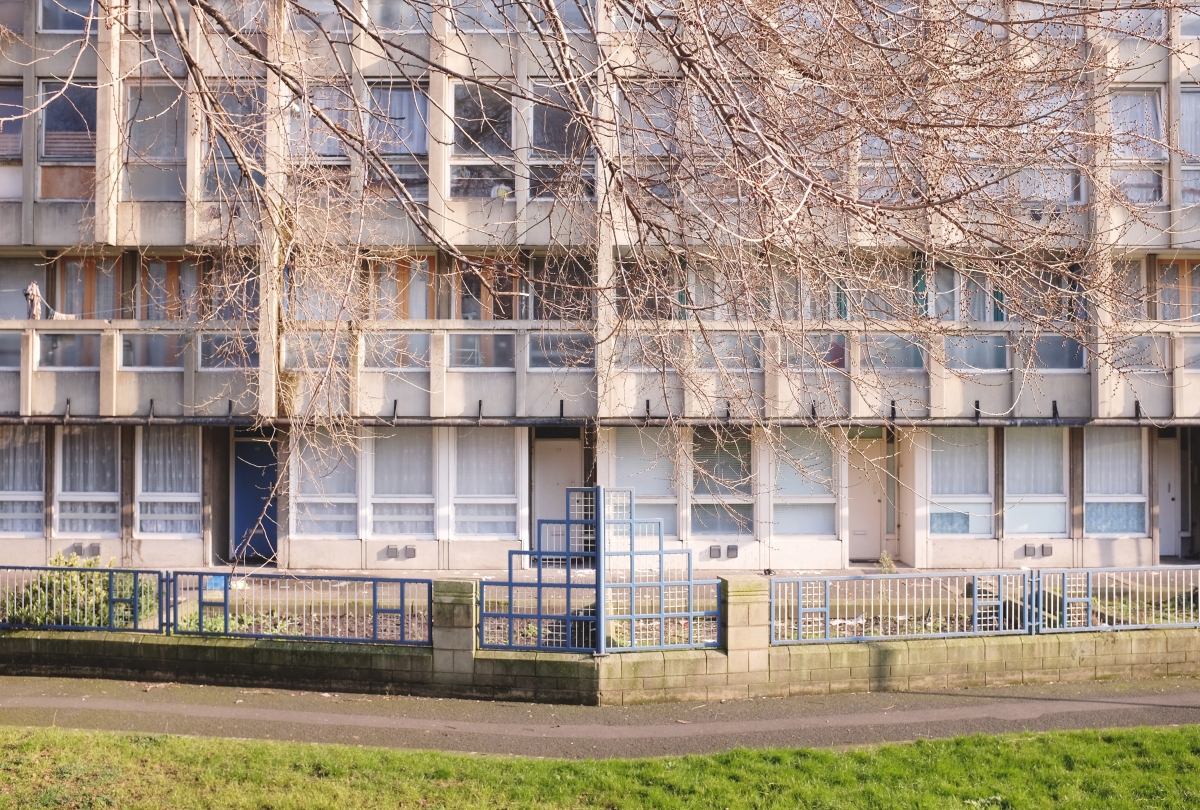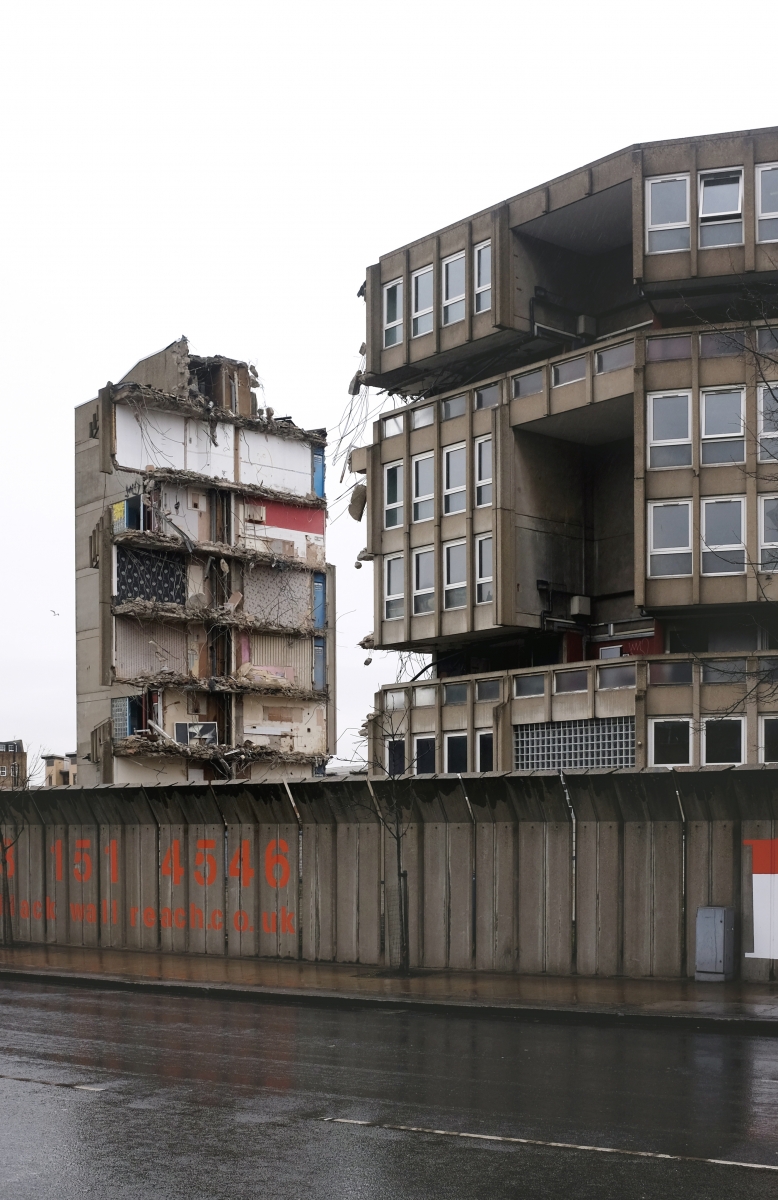
1972. Completion
2007. 8. The Council declared the site as part of a larger regeneration area named Blackwall Reach including Robin Hood Gardens ▶
2007. 11. The Twentieth Century Society proposes the Robin Hood Gardens for registration as an English Heritage site to the Department for Digital, Culture, Media & Sport (DCMS) but is unsuccessful ▶▶
2008. 9. The Twentieth Century Society promotes the campaign to request a review of the listing and not to demolish the Robin Hood Gardens ▶▶▶
2009. DCMS restates their view and a Certificate of Immunity from listing was issued for the subsequent five years
2012. 3. Demolition plan accepted
2015. Richard Rogers and Simon Smithson offer public messages of support to list the site and to save Robin Hood Gardens ▶▶▶▶
2017. Demolition begins
2017. Victoria and Albert Museum (V&A) partially archived 3-story spaces during demolition ▶▶▶▶▶
2018. 5. – 11. V&A exhibits ʻRobin Hood Gardens: A Ruin in Reverse’ at the 2018 Venice Biennale
2018. Demolition concludes
▶ From the report ‘Blackwall Reach Development Framework: Initial Sustainability Appraisal Reportʼ
The Site is located within the London Borough of Tower Hamlets (LBTH) an area of east London which is presently undergoing significant change and redevelopment. There are several major regeneration projects transforming the area from its former industrial setting, to the preferred location for financial and commercial industries and new private and affordable homes. This is evident both at Canning Town and Canary Wharf, two areas that surround the Site, to the east and west respectively. In addition, further to the east of the Site in the Lower Lea Valley, significant redevelopment and regeneration is planned to coincide with the construction of venues and supporting infrastructure for the 2012 Olympic Games.
THE DEVELOPMENT FRAMEWORK STRATEGIC OPTIONS
Option 1. Redevelopment of the Site with the retention of Robin Hood Gardens: This Option would involve the refurbishment of Robin Hood Gardens to a basic Decent Homes standard. A small number of buildings to the south of Woolmore Street would be removed to enhance the quantity of locally available public space.
Option 2. Redevelopment of Blackwall Reach with the replacement of Robin Hood Gardens: This Option would involve the redevelopment of the Site, with the replacement of the Robin Hood Gardens residential block with a mixture of new high quality housing, ranging in types and tenures and a new high quality green space located in the centre of the regeneration area.
(Tower Hamlets, ʻBlackwall Reach Development Framework Initial Sustainability Appraisal Report’, February 2008)
▶▶ Two opposing comments on listing ‘Should the government list Robin Hood Gardens?ʼ
YES. As well as thoroughly appraising the historic importance of the site, we visited the estate with a member of the housing department and talked to residents, some of whom invited us into their homes. We saw that contrary to popular myth, the estate is fully let, vandalism is minimal and there is a well established community atmospher. Kids play on the Smithsons’ ʻstreets in the sky’ and everyone loves the views. We passionately believe that it is important to keep the best buildings of every decade—and that we need to preserve the ʻreal thing’ so that future generations can have a sense of scale, of context and the sheer materiality of a structure. How was it put together? What did the spaces feel like? What sounds did you hear? Was it windy or sheltered? These questionscould never be answered by a digital record. Only a very tiny minority of post war public housing estates are ever likely to be listed. Robin Hood Gardens is clearly near the top of most people’s lists. With cash to upgrade the building, and better maintenance, it can survive not only as a record of innovative theory, but as a humane and enjoyable place to live. List it immediately!
- Catherine Croft
NO. Keep it, yes. List it, no. The Smithsons were solid as theorists but pretty uneven as designers and architects, and Robin Hood Gardens is probably their worst. In fact it is a dog of a building that does neither its designers nor their admirers any favours. It is hard to believe that the Smithsons could design something as subtle and as delightful as the Economist Building, and a bit later on do something as drearily, dreadfully bad as this. Inevitably though there is a problem with any proposal to replace it which is that whatever they build in its place is certain—to be worse. So I would argue for keeping it, but not on any account listing it, so that it can be transubstantiated from something ugly into something beautiful. That way you take advantage of its too-expensive-to-build-now decent sized flats and its embodied energy, and no-one has to move out; but you can gladly lose its grim-faced miserableness and make something finer and happier and friendlier.
- Robert Sakula
(Catherine Croft · Robert Sakula, ʻShould the government list Robin Hood Gardens?’, Building Design, 7 March 2008)
▶▶▶ In the campaign by Twentieth Century Society
We have requested a review of the Department for Digital, Culture, Media & Sport (DCMS)’s decision not to list Alison and Peter Smithson’s Robin Hood Gardens. What contemporary architects and academics have to say about Robin Hood Gardens. The Smithsons were the first architects of twentieth century Britain to make a hugely significant contribution to world architectural discourse, and Robin Hood Gardens is an outstanding example of post-war British architecture.
The design of Robin Hood Gardens is an interpretation of the familiar London street, albeit as a vertical model to allow an efficient use of land, thereby addressing the need for high density developments, but simultaneously sensitively maintaining a community environment by factoring in large communal garden squares.
- Zaha Hadid
As a teacher, I have often referred to Robin Hood Gardens, and have led visits to the building… It is innovative not only for the organisational idea, but also for the way in which the buildings organise the whole space of the estate, giving it a strong identity in a very hostile situation.
- Peter St John & Caruso St John
Robin Hood Gardens is a highly significant example of post-war public housing and, like the C19 Board Schools and the early C20 Garden Cities, signifies the progressive state of architectural design and public expectation at a time of change and social advance… Like Victorian architecture and Pre-Raphaelite paintings, which were laughed at for many years, it will come to be appreciated for what it is.
- Neil Jackson
In spite of all the controversies surrounding their work, then and now, [the Smithsons’] must be rated as Britain’s most important architectural designers, and especially architectural thinkers, during the period 1950 ‒ 1970. Their idea of community architecture was exceedingly influential throughout the world. Robin Hood Gardens is the only proper concrete manifestation of their concepts and is thus of extreme importance, not only historically speaking, but also for the present, as the concept of ʻdesign for the community’ still holds its fascination for architects and housing reformers.
- Stefan Muthesius
▶▶▶▶ Letter from Richard Rogers and Simon Smithson
I am writing to ask you to support listing Robin Hood Gardens as a building of special architectural interest, in order to protect one of Britain’s most important post-war housing projects, designed by Alison and Peter Smithson, from demolition. Previous efforts in 2009 to have the building listed failed, but the case has now been re-opened and we understand that the new Minister for Sport, Tourism and Heritage will be reviewing the arguments at the end of this week. The buildings, which offer generously-sized flats that could be refurbished, are of outstanding architectural quality and significant historic interest, and public appreciation and understanding of the value of modernist architecture has grown over the past five years, making the case for listing stronger than ever. The UK’s Twentieth Century Society has submitted a paper setting out why they believe Robin Hood Gardens should be listed (i.e. added it to the statutory list of buildings of special architectural and historical interest). Last time listing was considered the views of the architectural community were ignored but we believe there is now a real chance of saving the building for posterity but only if the Minister hears, first hand, the views of the profession on the architectural merits of these exceptional buildings. Can we ask you to support the efforts of the Twentieth Century Society by writing right now to the Minster to support listing and saying why you believe Robin Hood Gardens should be saved? Also, can we ask you to forward this e-mail to anyone else you know who might be willing to help save these important buildings?
▶▶▶▶▶ Victoria and Albert Museum partially acquired Robin Hood Gardens
The Victoria and Albert Museum (V&A) is acquiring a section of Robin Hood Gardens—a defining example of Brutalist architecture and social housing. Robin Hood Gardens, located in Poplar, East London, is a nationally important and internationally recognised work of Brutalist architecture. Completed in 1972, the building was designed by Alison (1928 –1993) and Peter Smithson (1923 – 2003), British architects of lasting international reputation. It is now being demolished as part of the redevelopment of the area. The V&A is acquiring a three-storey section, both the exterior facades and interiors of a maisonette flat, as a significant example of the Brutalist movement in architecture. Brutalism arose in the 1950s in reaction to the sleek and elegant glass structures of modernism. It was characterised by the dramatic use of exposed concrete to create facades of often repeating geometrical forms. Not only a style but also a philosophy, Brutalism sought to reframe the relationship between society, architecture and urbanism. The term Brutalism has frequently been applied to the work of the Smithsons, particularly Robin Hood Gardens. The estate was built by the Greater London Council (GLC) and later transferred to the local authority of Tower Hamlets. The choice of Alison and Peter Smithson as architects gave this wife and husband team their first and only opportunity to create a council estate. Robin Hood Gardens was the culmination of their research on and vision for social housing. It is distinctive for its noise-reducing features, like exterior concrete fins, and for its elevated walkways, known as ʻstreets in the sky’, intended to foster interaction between neighbours. The Smithsons regarded Robin Hood Gardens as, “a demonstration of a more enjoyable way of living … a model, an exemplar, of a new mode of urban organisation”. Both during their lifetime and since, there has been heated debate as to whether or not the building successfully realised these aspirations. No other work of British social housing has divided opinion to such a great extent. The announcement in 2008 of the intent to demolish Robin Hood Gardens prompted one of the largest ever campaigns in architectural preservation, initiated by the Twentieth Century Society and Building Design and supported by an international array of architects, including Richard Rogers and Zaha Hadid, as well as leading architectural historians. In 2015, the application to give Robin Hood Gardens listed status was turned down and demolition was approved. The site is now under development to replace the 252 flats with over 1,500 new homes. Since its foundation, the V&A has preserved and exhibited large fragments of architecture— from the 17th-century timber facade of Sir Paul Pindar’s House in Bishopsgate, London, to the gilded Music Room salvaged from Norfolk House in St. James’s Square, London. The three- storey section of Robin Hood Gardens joins the Museum’s world-renowned architecture collections, ensuring that a part of the building will remain in a public collection for future generations. The acquisition has been made possible by the development partners, Swan Housing Association, London Borough of Tower Hamlets and the Mayor of London who together have collaborated with the V&A Team and muf architecture/art in the removal of the section.





